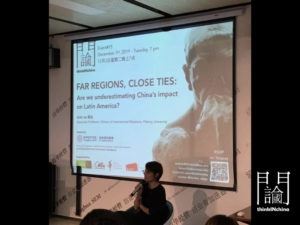

SPEAKER
GUO Jie 郭洁, Associate Professor, School of International Studies, Peking University
VIDEO INTERVIEW (published on YouTube, VPN needed)
REPORT
Tan lejos, tan cerca. So far away, so close. When it comes to Latin America and China, many would assume that the striking geographical distance between these parts of the world would impose limits on their proximity. As ThinkINchina event#75 speaker Guo Jie, an associate professor at Peking University’s School of International Studies, mentioned at the very beginning of her lecture, even former Chilean president Michelle Bachelet once said that “if Chileans keep digging down in the ground, they will eventually reach China.” While for a great number of Latin Americans it might be true that China has taken the imaginary form of a distant land, as political and economic ties expand, professor Guo argues, these two far-flung places are growing closer than ever before.
Starting with the theme of trade, Guo Jie claimed that China’s accession to the World Trade Organization in 2001 opened a window of commercial opportunities between China and Latin America. Soon enough, China became an important source of imports as well as a key destination of exports to a number of nations within the region. From the beginning of the XXI century until 2018, the bilateral Sino-Latin American trade volume increased 24 times — surpassing 300 billion USD last year. Today, China is the largest trading partner of countries including Brazil (the largest Latin American economy), Chile, Peru, and Uruguay. Furthermore, the Asian giant comes second in Argentina, Colombia, and Venezuela, among a few others. Behind this “trade miracle”, important structural issues persist, professor Guo argued. The asymmetric profile of the commercial flows between China and Latin America is particularly serious. While Latin American countries mainly sell agricultural or extractive products to China (such as soybeans, ores, petroleum, copper), the Chinese, on their turn, import more diverse and mostly manufactured exports (like electrical machinery and equipment, machinery and mechanical appliances, motor vehicles and parts). Optimising the trade structure, expanding new trade areas, and enhancing mutual trade security are the main challenges to ensure that China and Latin America advance towards a healthier and more sustainable relationship, Guo asserted.
Moving on to outward foreign direct investments (OFDI), professor Guo Jie pointed out that, although more scarce investments activities have occurred for a longer period of time, Chinese investments in Latin America have mostly take place during the last decade. Initially, around 80% of such investments were characterised by a resource-seeking strategy. In the last few years, China’s OFDI to the region have achieved considerable diversification related to the investor type, investment field, and geographical distribution of ventures. Investments have no longer only been a mean of gaining natural resources, but rather an opportunity to explore overseas markets, reduce production and logistics costs, transfer overcapacity, increase competitiveness, and increase R&D competence. Despite a sustained slowdown over the past five years, Chinese capital flows to the region continue to grow.
Professor Guo Jie also highlighted the diplomatic relations between China and the largest economy in the region – Brazil. As a case study, professor Guo analysed president Jair Bolsonaro’s radical shift in his previous anti-China rhetoric during his first visit to the world’s second-largest economy in October 2019. The “Old Bolsonaro” and “New Bolsonaro” depict an economic pragmatism that puts aside common populist discourses on China, in favour of a proactive partnership established through bilateral platforms and multilateral cooperation frameworks, such as BRICS. Despite this, “the Bolsonaro factor” cannot be ignored, as political ideology still matters. Meanwhile, the possible continued deterioration of Sino-US relations – in trade and beyond – will inevitably bring uncertainties to the current strategic partnership between China and Brazil, professor Guo declared.
For a long time, geography has prompted China and Latin America to see each other merely as exotic, mythical and magical places. With continuing globalisation and deepening of mutual exchange, the ties between the two will expand from merely the flow of goods and capitals, to influencing politics, culture and historical processes at large.
Report written by Jordy Bolivar Pasa
For learning more about China – Latin America relations, be sure to subscribe to Shūmiàn 书面, the first website and newsletter service in Spanish and Portuguese focusing on China.